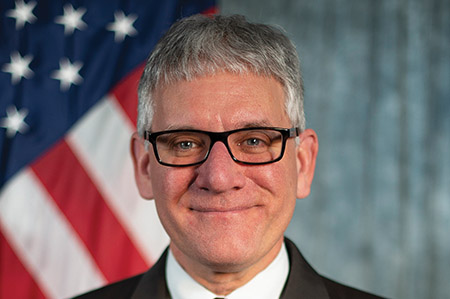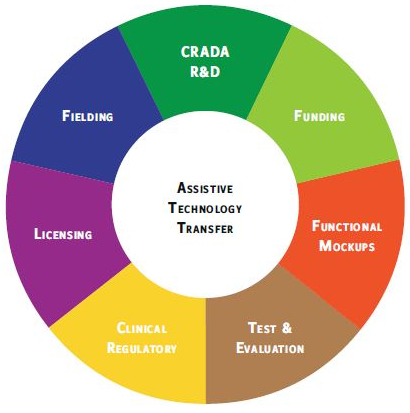Working With The U.S Army To Achieve Tech Transfer Success
By Edward Diehl
 The U.S. Army is a powerhouse of medical research that takes place at multiple facilities worldwide. The mission of Army medical research is to discover, develop, and deploy products that will maintain the readiness of our warfighters (soldiers, sailors, and airmen), protect them from disease, and improve battlefield survivability.
The U.S. Army is a powerhouse of medical research that takes place at multiple facilities worldwide. The mission of Army medical research is to discover, develop, and deploy products that will maintain the readiness of our warfighters (soldiers, sailors, and airmen), protect them from disease, and improve battlefield survivability.
Many of these products are dual-use, with significant potential to serve the civilian market. Under the jurisdiction of the U.S. Army Medical Research and Development Command, or USAMRDC, the Medical Technology Transfer (MTT) office finds the best pathways for technologies to successfully move toward commercialization.

LICENSE AGREEMENTS AND CRADAS
Army medical technologies in development are in many ways similar to those found in typical academic medical units and include drugs, diagnostics, vaccines, devices, software, and AI/machine learning. Invention disclosures, which are required by Army Regulation 27-60, are obtained via self-identification by researchers as well as through aggressive internal marketing and outreach by MTT licensing officers and staff. One very effective disclosure procurement method has been the inclusion of MTT personnel in the U.S. Army Medical Research Institute of Infectious Diseases (USAMRIID) manuscript approval process, allowing MTT to screen every research article and presentation prior to delivery to the public. Invention disclosures are evaluated at the monthly meeting of the USAMRDC Invention Evaluation Committee (IEC), composed of personnel from MTT, IP experts at the Judge Advocate General (JAG) office, ad hoc subject matter experts, and the inventors of the individual technologies. Robust support from in-house IP counsel in the JAG is a unique and vital component of USAMRDC technology development. Invention disclosures transition to provisional patent applications if there is a business case, and if interest is obtained in the subsequent nine or 10 months, a U.S.-only application is often filed. If a commercial partner expresses interest in foreign filings, these will be pursued at the partner’s expense. However, in many cases, it is determined by the IEC that the Army does not require patent protection in order to field products for the warfighter. A combination of modalities, including non-disclosure agreements and biological material licenses, can often facilitate and accomplish the MTT mission. A prospective licensee must submit an application for the materials or technologies of interest, and this includes information about their organization and development plan. License agreements are usually nonexclusive, unless a business case can be made for some form of exclusivity; license exclusivity requires notice in the Federal Register prior to the grant of the license. Multiple license agreements for one technology can sometimes be granted by specifying fields of use and other mechanisms to limit direct competition between licensees. The U.S. government requires substantial manufacture of any licensed subject matter in the U.S., although exceptions can be made if no company meeting that criteria is identified. According to Dr. Paul Michaels, director of the MTT office, “The MTT has an outstanding team made up of scientists with advanced degrees [one with U.S. Patent and Trademark Office (USPTO) experience], an engineer who is also a patent attorney, and business and financial experts with real-world experience.”
In addition to license agreements, another method for interaction with the USAMRDC is through Collaborative Research and Development Agreements, or CRADAs. The CRADA allows an outside academic, nonprofit, or for-profit organization or foreign government to work with an Army research laboratory or program office on projects of mutual interest. While the Army does not provide funding under a CRADA, the outside organization gains access to Army scientists, research facilities and equipment, and clinical and regulatory expertise. Intellectual property created through a CRADA is statutorily available to the partnering organization through an option for an exclusive license without a requirement for competition. CRADAs are powerful tools intended to drive business development through startups because of the positive view the investment communities hold for these agreements. Medium to large companies also can benefit from the pursuit of higher-risk opportunities.
AN “ASSISTIVE TECHNOLOGY TRANSFER ENTITY”
The USAMRDC MTT refers to itself as an assistive technology transfer entity, or “Assistive T2.” Since technologies developed by the Army are often desired to be deliverables for the Army to purchase, the MTT tries to ensure a high success rate once a deal is signed. According to Barry Datlof, MBA, the MTT chief of business development and commercialization, “We are constantly looking at technology transfer within a three-dimensional environment of science, business development, and commercialization. Especially when working with startups, we have to ensure that we help build bridges over each Valley of Death encountered. We are partners with our licensees and CRADA partners throughout the process.” The MTT works to make each agreement as attractive as possible for additional funding, and with respect to infectious disease technologies, Datlof was instrumental in incorporating the priority review voucher, or PRV, into deal structures. The PRV was invented by a team from Duke University in 2006 and created a secondary market to buy and sell FDA priority reviews for new drug applications not otherwise eligible for priority review. The opportunity for a large pharmaceutical company to purchase a priority review, with concomitant reduction in approval times of six months or more, gives the pharma market and sales advantages that justify the price tag of $100 million or more. Datlof notes, “If one deal with a PRV goes through, the licensing revenue generated can be invested back into additional research programs.”
The Army of the future will have increasing challenges in the medical arena, as will academic institutions and biotechnology and pharmaceutical companies. Through MTT licensing and partnerships, the Army will continue to support advances in medical technologies and simultaneously stimulate business and economic development.
The U.S. Army Medical Research and Development Command (USAMRDC), with a yearly budget of $2.63 billion as of July 2019, is composed of several subordinate commands located in the U.S. and with subsidiary laboratories throughout the world. The U.S. Army Medical Research Institute of Infectious Diseases (USAMRIID), located at Fort Detrick, MD, is the only Department of Defense laboratory that is authorized and equipped to perform research on biosafety level 3 (BSL-3) and BSL-4 organisms. Also located at Fort Detrick are the U.S. Army Medical Materiel Development Activity, the program manager for Combat Medical Systems with responsibilities ranging from the development of drugs to advanced combat casualty care, and the U.S. Army Medical Research Acquisition Activity, which provides contracting and assistance agreement support.
- The Walter Reed Army Institute of Research (Silver Spring, MD) — focuses on infectious disease and brain health research
- The U.S. Army Research Institute of Environmental Medicine (Natick, MA) — performs research to maintain health regardless of environmental conditions
- The U.S. Army Institute of Surgical Research (Fort Sam Houston, TX) — specializes in combat casualty care, including burns and other trauma, and is a world leader in blood and blood-product research
- The U.S. Army Aeromedical Research Laboratory (Fort Rucker, AL) — performs a wide range of research related to the health and well-being on the warfighter and also develops medical evacuation technologies
- The U.S. Army Medical Research Institute of Chemical Defense (Aberdeen Proving Ground, MD) — creates medical countermeasures to chemical warfare agents for both warfighters and civilians and also coordinates educational outreach.
Finally, the USAMRDC performs research in Thailand, Africa, and Georgia, and in collaboration with the Navy in Peru and Egypt. The USAMRDC also works closely with the Defense Health Agency’s military medical treatment worldwide.
EDWARD DIEHL is the commercialization officer for U.S. Army Medical Technology Transfer and has more than 25 years of experience evaluating and developing life sciences technologies.
